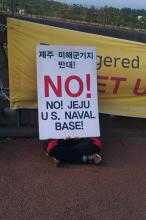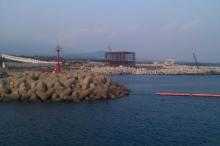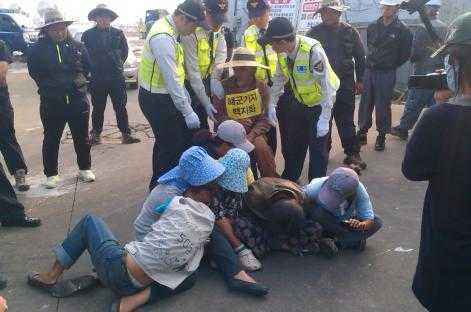Antimilitarism South Korean Style
Javier Gárate
During the first two weeks of October (2012), I visited South Korea, invited by the group World Without War to give a training for trainers in nonviolent action and to visit Gangjeong village, on Jeju Island, where people are resisting the construction of a naval base.
It is well known that South Korea is a militarised country, with the protracted conflict with North Korea being a permanent reminder of this militarisation.
For a decade WRI has been cooperating with South Korean antimilitarists. This began in 2001 when South Korean activists asked WRI for support in their work on conscientious objection. At that time there were hundreds of Jehovah's Witness COs in prison for their refusal to military service. In early 2002 political COs started to organise themselves, and WRI played an important role in supporting their work. Initially their CO work came more from a Human Rights perspective but rapidly it took a more antimilitarist approach, with nonviolence being an important identity for them. As nonviolence and antimilitarism took a more prominent role in their work, they started expanding their work beyond CO support. That is how World Without War (2003) came to existence as a group resisting war by nonviolent means.
As a direct consequence of the conflict with North Korea and a legacy from the Cold War, South Korea has around 70 US military bases in its territory. US Forces have been stationed in South Korea since 1950. Historically, their main role was to deter any possible war threat posed by North Korea. However, the USA's Global Posture Review changes the role of US Forces in Korea from a stationary army on the Korean peninsula into a regional hub for rapid deployment and capable of pre-emptive strikes. The Land Partnership Plan of 2002, agreed by South Korea and the USA, has re-organised forces into fewer but bigger bases and training areas. Bases previous clustered on the Demarcation Line have been closed, but the expansion of bases further south increases the capacity to send highly trained troops to other Asian 'theatres', with the Jeju base playing a crucial role in it.
Resistance to military bases has a long history in South Korea, with a wide variety of groups struggling against these bases. World Without War sees itself as taking the nonviolent direct action side of the resistance.
Nonviolence Training
World Without War has advocated and engaged in nonviolent action against the military bases and the different form of militarism in their country. This also includes their work against war profiteering, under their sister organisation, Weapon Zero. As part of this work they see nonviolence training as a key element in strengthening their commitment to nonviolence and helping to make their actions more effective. World Without War has been at the forefront of antimilitarist nonviolent actions in South Korea, carrying actions against military bases, war profiteering, military service, etc. Nonviolent direct action, however, is still a relative new concept within South Korean movements and there are strong criticism about it, but thanks to the strong commitment of World Without War and other sympathetic activists, slowly these perceptions are changing – nonviolence training has contributed to this change. Numerous World Without War members have participated in nonviolence trainings and some of them have carried out trainings.
As part of the cooperation with WRI, we had the idea of having a training for trainers, for activists to empower themselves to go out and give their own trainings, and this year (2012) the plans finally materialised, with a training for trainers taking place in early October. The training for trainers was organised by World Without War, but was open to activists from other groups. Mostly of groups engaged in the struggle against the naval base in Gangjeong, Jeju Island. As part of the whole training for trainers process, five preparatory sessions where held before the training, with World Without War members doing the facilitation. These sessions used WRI's Handbook for Nonviolent Campaigns as a guide for their sessions.
The workshop was led by Denise Drake, of the UK nonviolence training organisation Turning the Tide, and myself. It was held on Ganghwa island. This island is very near the border with North Korea, actually from the island you could see North Korea. The island is a two hours drive from Seoul, and I recommend not to fall a sleep during the journey – as I did even though there was a big tv screen on the bus – if not you will definitely miss the moment you get on the island, as it is very close to the continent and joined by a bridge.
Of North Korea I only saw some distant mountains, but just the feeling of being so close to this almost unaccessible country was special. I wished I had some binoculars to see more clearly. This excitement was shared by all participants, which goes to show how close but at the same time far is North Korea from South Korean people. The training was held at a beautiful complex, formed of a series of cosy cabins. Sleeping was Korean style, meaning good for your backs, on thin mats, which were a bit too exposed to the floor heating (useful in winter but this was autumn). Food was provided by a group from a Seoul Haebangchon Café Co-op under the name Bin-gagae and it was delicious, mostly rice and all forms of vegetable side dishes and with one night having Korean style Vietnamese wraps. Every evening we had a Peace Bar, with a good selection of beers and my favourite - soju. The Peace Bar raised funds to support the court cases of activists against the Gangjeong base.
The training itself focused on the facilitation side of nonviolence training. At the end of each day we had a long session under the title Today's Facilitation Points, which looked at what facilitation methodologies and tools we had used and how to adapt them to the South Korean context. After the first day we had to incorporate many more ice-breaking games as it was a common feedback from participants that South Koreans in general are shy when it comes to sharing in larger groups, and it is much easier for them to do the sharing in a more playful manner. Dancing is very important among South Korean activists, so we also learned some activist dances.
During the training we used the struggle in Gangjeon against the naval base as well as the action at Samsung's headquarters, where a group of activist poured red paint on them at the entrance of their offices - which is one of the main contractors of the naval base. If you still own a Samsung product, it is now time to get rid of it and join the boycott! This framework helped us to connect the training to actual struggles, for example an important discussion within the movement has been the phenomenon of shouting at police officers during the protests against the naval base. The point was not to agree if this is or not nonviolent, but what are the causes of it and what consequences this has. Another important issue was how to deal with people joining a direct action without being part of the preparation process, the pros and cons of this.
An important session was what we called facilitation practice, where pairs practised facilitating a session. One of the pairs after doing their session came up to me all excited saying “it is tough but fun”.
The training ended with a session on what's next? The proposal is to form a South Korean network of nonviolence trainers, and several tasks were set up to help this process. As trainer, I saw myself mostly as an excuse to get different activists together to share their experiences and share some limited experience I have. Clearly the knowledge and experience is there and there is huge capacity to work in nonviolence training in South Korea.
No to the Naval Base in Gangjeong Style
As part of WRI's work against war profiteering, and with the help of World Without War, WRI has repeatedly reported on the struggle against the naval base in Gangjeong, Jeju, mostly focusing on the role that Samsung is playing in the construction of the base. Also WRI's close friend, Angie Zelter, who visited Gangjeong for a month earlier this year, wrote an article for The Broken Rifle on her experience.
From the moment I knew I was going to go to South Korea I had in mind that I had to go to Jeju Island. I was still not familiarised with the name and even less with the pronunciation of Gangjeong. I have to say that before going to Gangjeong I knew little about Jeju Island, what I did know was that it is a beautiful island, with many natural wonders, including the highest mountain in South Korea – Halla Mountain - and that it is the place where they are constructing a naval base. When booking my flight to Jeju, I was surprised that there are flights from Seoul to Jeju every 15 minutes, which is more often than my local bus! Which goes to show that it is a highly popular destination mostly for Korean tourists, though there are more and more international visitors.
Once you arrive at Jeju airport you get the bus number 600, which takes you through the centre of Jeju city. Once you get out of Jeju city you cross the island, which provides an incredible view of it. 15 minutes before you arrive to Gangjeong village, you are driven through several big tourist resorts, which is a bit of a shock. When we approached Gangjeong village, passengers told me “the next stop is Gangjeong, where people protest”, I guess knowing that I was getting off there. The bus drops you almost in front of Gangjeong's Peace Centre, where you will always find someone to help you with information and it is the place where many meetings take place.
Gangjeong is a village of around 2,000 inhabitants, where people live from fishing and agriculture, mostly of delicious tangerines. For both fishing and agriculture water is a vital resource, and the naval base will affect both, as already the construction of the base is affecting the soft coral and the sea biodiversity as well as the blasting of the precious Gureombi rock. This rock is not only environmentally sensitive but also an ancient place of prayer - it is the only smooth volcanic fresh water rock in Korea. The fresh-water springs underneath the rock are believed to be the source of the Gangjeong Stream that provides 70% of the drinking water for the southern half of the Island, this water is also what keeps the agriculture going.
The naval base will be a South Korean base available for unlimited use by the US military, mostly to station aircraft carriers, nuclear submarines and other lethal weapon platforms. As Angie says in her article, when the plan to construct the base was announced, it was a huge shock for the people in Gangjeong as “the last time a military base was located on Jeju Island, in 1948, more than 30,000 people (a ninth of the population) were killed in a genocide that is known as Sasam. They were killed by the South Korean government under US military rule, 84 villages were razed to the ground and a scorched earth policy left thousands of refugees. People were not even allowed to openly talk about this trauma until 2006 when the late President Roh Moo-Hyun officially apologized for the massacre and designated Jeju an 'Island of World Peace'. You can imagine how terrible the sense of betrayal was when only 2 years later he agreed to build a naval base on Jeju.”
My hosts in Gangjeong were mostly people from the organisation The Frontiers, an organisation committed to peace building in conflict areas. In Gangjeong they do most of the international work as well as the sea direct actions. The founder of The Frontiers is Dr. Kang Ho Song, who a few days before I arrived had been freed from a six months prison sentence for his actions against the naval base. Members of The Frontiers share a house that a village person of Gangjeong lets them have for free, as a sign of support and appreciation for what they do. If you have come across the No Naval Base on Jeju facebook or twitter or the English newsletter, they are the main people behind them.
At the time of my visit the construction of the naval base was around 13% completed, so there is still the chance to stop it! As I was in Gangjeong a 1 month march against the base was taking place in the main land, covering most of the country, and which will end with a huge rally at the Seoul Square on 3 November. This meant that many of the regular protesters in Gangjeon were away, but still there was an important presence in the village. The resistance against the naval base is formed mostly of villagers together with what they call supporters (Gikimi), mostly coming from the mainland. I would like to use Angie's words here to say that “the resistance of the villagers and their supporters has been remarkable despite being repeatedly subject to arrest, imprisonment and heavy fines. The South Korean military claim that the base construction approval process was approved by a democratic vote was exposed as a lie. Only 87 people, some of whom were bribed (out of 1800 residents) had an opportunity to cast a vote, by applause only. When the village elected a new Mayor and held their own re-vote, that fairly included the entire community and was done by proper ballot, 94 percent of all villagers opposed the military base—yet the government and military refused to recognize these results.”
The day protest in front of the gates from the very little I could see has a bit of a routine. It starts at 7 am, with people bowing 100 times in front of the naval base gate, then the blockaders take their places in front of the two access gates to block the entry and exit of lorries and cars from the construction site. Every few hours the police comes in hundreds and removes the blockaders, without arresting them. As soon as the police leave, the blockaders take back their position. At 11 am there is a Catholic mass in front of the gate. When a few months ago all forms of protest at the gates were banned, mass was the only action allowed and it symbolised the continuation of the protest. After mass it is time for lunch, which is provided by the activist restaurant supporting the resistance (Samgeori). The police - not officially - have agreed not to interrupt the mass and to also not remove the blockaders during lunch time. In the afternoon there is more blockading and police removal, the blockaders always getting some refreshments from the activist cafeteria (Halmangmul). The day ends at 8pm with a candle vigil in front of the gates, which is also a time to talk and share information and experiences. The candle vigil almost always ends with one or more of the several dances which have become a trademark of the resistance to the base. Dancing is a very important form of protest in South Korea, and this could not be more true in Gangjeong, with the latest hit Gangjeong Style soon topping the rankings as most watched video. I tried to learn a few dances, and I am still practising while looking at the video clips. Check them out!
[video:http://www.youtube.com/watch?v=c3g5j4CrzBw width:400 height:300]
Throughout the five years of resistance against the construction of the base, villagers and supporters have inspired us with the resilience and courage to continue their struggle. This is one of the best examples of the importance of continuous resistance, as people are there everyday struggling against the base. Many activists have given up their life in the mainland to join the struggle, as Arundhati Roy argued “weekend demonstrations don't stop wars”. One question is how well they can combine their local protest with pressure in Seoul. The month long march ending in Seoul is a step in that direction. The continuous pressure on Samsung is also crucial. Perhaps South Korea's presidential elections in December will bring some renegotiation of the relationship with the USA, and Catholic bishops have petitioned that this should include cancelling Jeju. One of the most famous anti-militarist struggles - the decade-long resistance to a firing range on the Larzac in France - resulted in 1981 in the newly-elected French president, François Mitterrand, keeping his promise and cancelling the plan. Nothing like that is likely with Jeju, however, until the movement grows even stronger. Therefore the movement needs a longer term perspective - and could certainly benefit from the long-range support and encouragement of those far away who see the importance of this struggle. Boycott Samsung - share information on what's happening in Gangjeong - write to or picket your nearest South Korean embassy. Join the Facebook cause if that's your way. Let's all find some way to say "No to the Naval base on Jeju Island!"
For more pictures go to: http://wri-irg.org/node/20503 or to Facebook




Add new comment